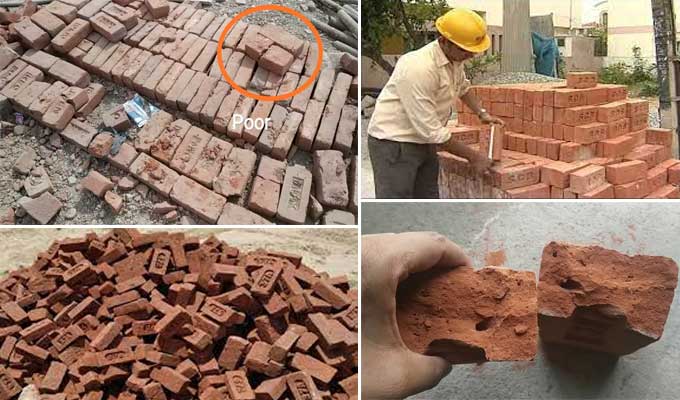
Types of Tests on Bricks for Building Construction Works
A structure is built with bricks. An example of a brick is a rectangular block of material used to make the walls of a building. Clay is the most commonly used material for bricks, though calcium-silicate and concrete are also commonly used. Buildings are mostly constructed of brick.
A brick should not react with any material, so it will be chemically inert when combined with any material. Engineer must know how to test and inspect bricks on the construction site.
1. Water Absorption Test
Under extreme conditions, the absorption test measures how much moisture brick can absorb. This test consists of taking five bricks, weighing the bricks dry, and determining the average brick weight.
Afterward, the bricks immerse in 29?C clean water for 24 hours. The average of 5 bricks is calculated after the immersion. As the weight of bricks fluctuates over time, it provides clues as to how much water each brick absorbs. A dry weight of as much as 20% of bricks should be allowed in any case.
2. Visual Inspection
You break a brick from a group in this test. You examine the interior brick carefully. You must make sure it does not have any holes, cracks, or flaws.
Each brick inspects for its size, color, and shape in this test. An ideal brick should be rectangular, with sharp edges, and uniform in shape. Bricks are 190 mm in length, 90 mm in breadth, and 90 mm in height.
3. Dimension
Compare the length, width, and height of 15 - 20 bricks. Therefore, every brick must be the same size to use for construction. There was a tolerance of +/- 3mm in class one and +/- 5mm in the other classes.
4. Efflorescence
A good brick doesn't need to contain soluble salts. Bricks become efflorescent if they contain soluble salts. Put a brick in the shade for 24 hours in a water bath. You should conduct this test in a well-ventilated room. When there is white or grey residue on the surface of the brick, the quality is poor as it contains soluble salts.
Sodium, potassium, and sulfate should not be present in soils used to produce bricks. When such salts are present in bricks, they are going to dissolve when in contact with water.
Salts found on bricks, when used for exposed surfaces, can cause serious surface disruption, which may damage outer plastering. This phenomenon is known as efflorescence.
5. Hardness
Bricks tested for hardness using this method. When a brick is durable, it shouldn't scratch easily. The test is conducted by scratching a brick with a sharp tool or fingernail.
It considers good quality brick if no impression is left on its surface. As part of this test, your bricks drop from 1.2 to 1.5 meters in the air. It is not agreeable for construction work if bricks break.
6. Crushing Strength
A brick is placed in this machine to test its compression. When using a compression machine to test bricks, apply loads until bricks begin to break, just like with cube testing. The crushing strength of the brick must be 3.50 N/mm2 to be considered a good brick.
7. Brick Color
Well-burned bricks are of good quality. Any brick with a reddish or cop perish color suggests it is under- or over-burnt. The shape of bricks will change if they are over or under baked.
For online brick calculation and more information, go through the following link www.source4me.co.uk
To get more details, watch the following video tutorial.
Video Source: Civil Site visit


